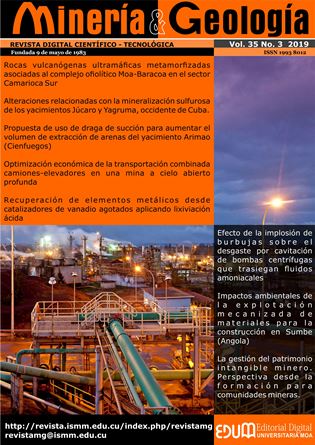Bubbles implosion effect on cavitation wear of centrifugal pumps that transfer ammoniacal fluids
Keywords:
cavitation wear, centrifugal pump, bubble implosion, ammonia liquor, microstructural analysis, Hastelloy C 276Abstract
This article exposes the effect bubbles implosion causes on buckets on the liquor from carbonate-ammonia leaching (mixture of water, ammonia and particles in suspension) of ferronickel lateritic ores. Based on the previous results that establish a relationship between the bubbles’ size and the ammonia concentration of the liquor, the microstructure of a Hastelloy C 276 steel blade affected by cavitation was analyzed. It was also obtained that affectations are smaller in the initial area of the bucket than the distal parts, where complete perforations can be produced in the metal, what is associated to the fact that bubbles develop a great size at a concentration of 34% of ammonia in the liquor and implode at the exit of the bucket producing more intense pressure waves than those generated by the bubbles formed at 27% and that implode in the initial zone. It is concluded that the microstructural changes in the bucket material are closely related to the concentration of ammonia in the liquor making pitting, cracks, and cavities larger when the concentration of ammonia is maximum (34%).Downloads
References
REFERENCIAS
Alcántara, D.; Fernández, T. y Rodríguez, I. 2016: Influencia de la pulpa lixiviada sobre el desgaste de una aleación del tipo Hastelloy C 276. Minería y Geología, 32(1): 93-105.
Caron, M. H. 1950: Fundamental and Practical Factors in Ammonia Leaching of Nickel and Cobalt Ores'. JOM-Journal of the Minerals, Metals and Materials Society, 2(1): 67-90.
Dopazo, G. C. 2008: ¿Cavitar o no cavitar? La inevitable ubicuidad de las burbujas. Discurso leído en la sesión inaugural del año académico 2008 de la Real Academia de Ingeniería de España. Madrid. 50 p.
Guitar, M.; Duarte, M. y Montero, Y. 2003: Comportamiento frente al desgaste y corrosión de un acero inoxidable AISI 304 nitrurado por plasma. In: Actas de las Jornadas SAM / Congreso CONAMET / Simposio Materia. Bariloche, Argentina, 17-21 noviembre, p. 722–725.
Haoulo, M.; García, F. y Soto, J. 2005: Gradiente de presión de flujo de gas y líquido en tuberías horizontales considerando el efecto de las propiedades de mezcla. Revista de la Facultad de Ingeniería, Universidad Central de Venezuela, 20(4): 102-113.
Lo, K.; Shek, C. y Lai, J. 2009: Recent developments in stainless steels. Materials Science and Engineering, 65(12): 39-54.
Mesa, D.; Garzón, C. y Tschiptschin, C. 2010: Estudio del desgaste erosivo por cavitación de un acero austenítico de alto nitrógeno apoyado en el uso de la difracción de electrones retroproyectados-EBSD. Ingeniare. Revista chilena de ingeniería, 18(2): 235-242.
Pérez, R. 2004: Cavitación y Materiales de Construcción en las Bombas Centrífugas. Minería y Geología, 20(3-4): 114-118.
Ramírez, R.; Jácome, M. y Giraldo, A. 2013: Solución de la ecuación de Rayleigh-Plesset por medio del método del elemento finito. Ingeniería y Ciencia, 10(2): 23-31.
Reyes-Cruz, J. 2015: Presión de saturación del licor amoniacal y su relación con el fenómeno de cavitación en bombas centrífugas. Minería y Geología, 31(1): 45-54.
Reyes-Cruz, J. 2016: Dinámica de las burbujas de cavitación en fluidos amoniacales trasegados con bombas centrífugas. Minería y Geología, 33(3): 128-146.
Romo-Arango, S. A. 2014: Evaluación de la resistencia a erosión por cavitación de superficies texturizadas. Tesis de maestría. Universidad Nacional de Colombia.
Torres, H. S. 2010: Generación de burbujas de cavitación con láser continuo para la formación de micro agujeros en películas metálicas delgadas. Tesis doctoral.
Published
How to Cite
Issue
Section
- Authors retain copyright and guaranteeing the right magazine to be the first publication of the work as licensed under a Creative Commons Attribution-NonCommercial that allows others to share the work with an acknowledgment of the work's authorship and initial publication in this journal.
- Authors may establish separate supplemental agreements for the exclusive distribution version of the work published in the journal (eg, place it in an institutional repository or publish it in a book), with an acknowledgment of its initial publication in this journal.
- Authors are allowed and recommended to disseminate their work through the Internet (e.g., in institutional telematic archives or on their websites) before and during the submission process, which can produce interesting exchanges and increase citations of the published work. (See The effect of open access)




